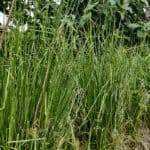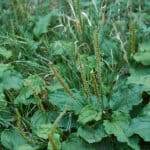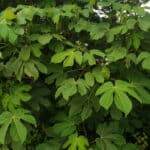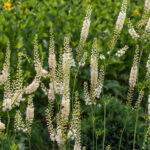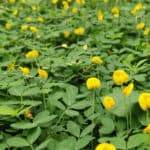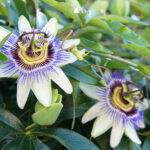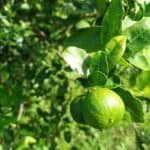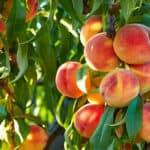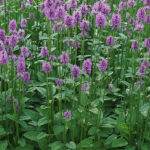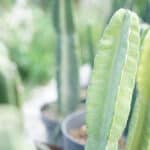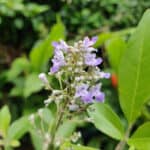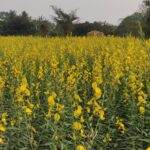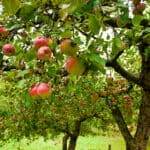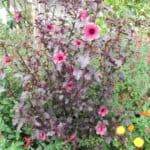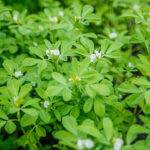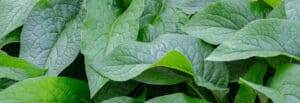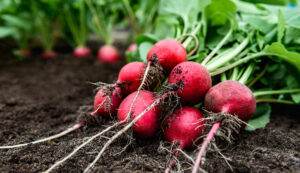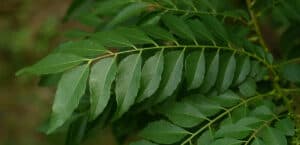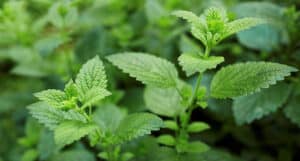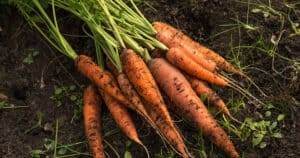Many people call Moringa oliefera a miracle tree. Others refer to it as a tree of life. For those of us practicing permaculture in the tropics or subtropics, it represents everything we want from one plant– the ideal stacking functions tree. We say that because all parts of the tree are edible, it has medicinal properties, and animals love it.
So let’s get prepared to dig deep into this miracle tree. We’ll explain how to grow, care for, and harvest moringa. Then we’ll explore the various ways you can utilize your moringa bounty.
We’ve even found a surprising way you can use a moringa waste product to clean drinking water!
Intrigued? Keep reading to learn more.
Plant Overview

Moringa oliefera is known by many names. It is often called the drumstick tree after its iconic seed pods or the horseradish tree for its spicy roots. Whatever you choose to call it, the fast-growing, attractive tree is an excellent addition to a tropical food forest.
Moringa trees can grow as tall as 40 feet if left alone, though we recommend pruning them regularly. The leaves are teardrop shaped and grow from thin stems in clusters. The leaf clusters fan out and provide dappled shade.
After two to three years, the tree will develop delicate, fragrant white flowers that bees, butterflies, and hummingbirds love. Later the flowers will develop into seed pods. The seed pods start out green and skinny, with a little bit of a wiggle. This shape gives rise to the name drumstick tree. As the pods mature, they plump up and brown.
Moringa is native to the Himalayan foothills in India. People in that region have cultivated Moringa for more than four thousand years for its medicinal and nutritional qualities. In Ayurvedic medicine, for example, it is used to treat over 300 separate conditions.
Nowadays, Moringa is grown around the world in tropical and subtropical regions. Its high nutritional value makes it an important dietary addition in malnourished communities. And when we say high nutritional value, we mean high.
Take a look at how moringa stacks up according to Trees For Life International.
Moringa has:
- Seven times more Vitamin C than is found in an orange
- Four times more Vitamin A than is in a carrot
- Four times as much Calcium as a glass of milk
- Three times the Potassium that’s in bananas
- Twice as much protein as yogurt
With numbers like these, it’s no wonder there’s so much buzz over this miracle tree. Let’s look at what you need to do to get it growing in your food forest.
Propagation & Planting

One of the many benefits of moringa is that it is very easy to propagate. You can propagate moringa either from seed or cutting. And luckily, both methods have high success rates. You can plant moringa trees close together to create a fast-growing living fence, and mature trees are effective for erosion control.
Propagating from Seed
Seeds have an extremely high germination rate, so you can feel confident direct seeding moringa. Though if you prefer, you can start moringa in plant bags and simply transplant the saplings later. Moringa seeds don’t have a dormancy period, so you can plant recently harvested seeds. If you don’t have access to seeds locally, look for reputable dealers on the internet.
When direct seeding, look for an area with light, sandy soil. Moringa doesn’t thrive in hard-packed clay or water-logged areas. When you have found your ideal location dig a small hole, maybe one-foot square. Mix compost and nutrient-rich soil to fill your holes, as this will help your moringa seeds thrive. Once you prepare your hole, place three to five seeds in the hole spaced a couple of inches apart. They don’t need to go into the soil too deeply. Just gently press them down.
Keep your soil moist, and keep an eye out for your seedlings. They should start to appear in about two weeks.
Propagating by Cutting
Propagating moringa by cutting is another easy method. This method allows you to harvest leaves and seeds earlier than plants grown from seed. While I planted from seed to get started, now I propagate by cutting whenever I feel the need to prune my moringa trees. You won’t believe how effortless it is.
I simply cut the branches from my moringa tree, which is remarkably easy as the branches are very weak. Then I stick them in the ground. I aim for branches that are around three feet or taller. Once I have my branch, I dig a hole and place the branch in the hole. I want a good foot or so of the branch to fit into the hole. Once that’s done, I simply fill the hole back in with light sandy soil.
I make sure I water the new tree regularly, and soon it develops roots. Just like that, I have another moringa tree. (See, I told you it was simple).
Growth & Care

Just like propagation, moringa care is pretty straightforward. But you must keep in mind that moringa thrives in US hardiness zones 9 and 10. If you live in a colder climate, your trees may struggle and completely die off to the ground during a freeze but will often resprout in the spring as long as the roots remain alive.
Moringa trees like full sun and require a minimum of six hours of sunlight. While they prefer to grow in humid, jungle-like climates, moringa is quite drought tolerant once established. However, for your plant to flourish, you want to make sure it gets adequate water.
While my moringa trees have luckily been pest free, they can be susceptible to certain insects. Caterpillars, aphids, cutworms, and stem borer beetles can all be potential problems for moringa. If your tree is suffering from an insect infestation, try treating it with an organic pesticide like neem oil.
The most crucial aspect of moringa care is pruning. Moringa grows so fast that the trees can quickly become enormous monstrosities. To keep this rapidly growing tree in check, make sure you prune it regularly. You’ll find that the branches and trunk are weak, which makes pruning a breeze.
Simply grab some pruning shears and start loping off branches until you have the shape you want. It’s common to cut moringa trees back to a height of three feet at least once a year. Don’t worry! They will grow back before you know it. Pruning your tree is a great way to harvest leaves for eating or drying or branches for propagating more moringa.
Harvesting

As we mentioned, all parts of the tree are edible. The easiest way to use moringa is to harvest the leaves fresh. I have a moringa tree growing in my front garden and routinely clip leaves and branches to use in my dinner.
My tree maintains leaves and flowers year round but only produces seed pods in the rainy season. You should harvest the pods when they are skinny and young if you plan to cook with them. Simply snap them off the tree– easy peasy.
If you want to make oil or have seeds to plant, you will want to leave the pods to develop further on the tree. You will notice that they get woodier as they ripen. If you continue to leave them on the tree, they will ultimately open where you can see the seeds inside.
I still struggle with knowing exactly how to harvest my seed pods to use the seeds. If you gather too early, the seeds inside are not fully mature. But because the seeds mature during our rainy season, they can mold. Often when I wait to harvest my pods, I find that the seeds have molded or ants have invaded the pods. I find squeezing my closed pods can help me determine if they are ready.
Processing & Utilizing

There are many different ways to utilize moringa. As I mentioned, the easiest way is simply to use the leaves fresh from the tree. Use them fresh as greens, cook with them, or brew them into tea. Some cultures even mash up the leaves to use as a poultice to treat skin conditions.
Not only can people eat the leaves, but animals also love them. In fact, my goats are happy to munch on all parts of the moringa tree, leaves, flowers, and seed pods. And the best part about it is that studies have shown moringa can help boost lactation, which is exactly what I want for my nanny goats.
If you have more moringa leaves than you and your animals can eat fresh, the leaves can be processed and utilized later. All you need to do is dry them out in some kind of dehydrator. Even a simple solar dehydrator works. Once your leaves are dry, you can use a blender to grind them into powder. You’ll want to store the powder in an airtight container– glass jars or zip lock bags work well.
Our favorite way to use moringa powder is to add it to a fruit smoothie. Just a spoonful or two can pack in a ton of extra nutrients. But really, you can add moringa powder to all sorts of different things. And not all of them are food. I’m excited to try adding moringa powder to my homemade soap. Not only does moringa have excellent cosmetic properties, but it can also add a beautiful green color.
But you can eat more than just the leaves. I’ve been known to pop the flowers straight off the tree into my mouth. They don’t have a whole lot of flavor, just a hint of sweetness. I’ve read that the flowers can be fermented in honey and used as a cough syrup, but that experiment is another still on my to-do list. You can add the young, green seed pods to curries, soups, sauces, sauteed, or even pickled. You’ll find them used in many different traditional cuisines.
The mature seeds are also edible in small quantities but are more commonly either planted or pressed into oil. It takes a lot of seeds to make a small amount of moringa oil, so you will find it expensive to buy or time-consuming to make.
Supposedly you can make moringa oil by roasting, then cracking the seeds, and finally boiling them in water. The oils will collect on top of the water. I can tell you I have not tried this method with moringa, but I have done something similar with coconuts. It’s a lot of work for a little yield. We wound up buying a small oil press instead and used this to make oil. And I have still not accumulated enough seeds yet to be worth pressing (we just keep planting them instead).
You can use moringa oil as cooking oil, though you want to use it sparingly. More commonly, it’s found in cosmetic products, like soaps, shampoos, and lotions.
If you go through the trouble of making oil from your moringa seeds, don’t throw away the empty seed casings. Permaculture is all about zero waste, and this “waste product” has surprising properties. Numerous studies have shown that the seed cake remaining after moringa oil production can effectively filter sediment and even bacteria and viruses from drinking water. How amazing is that!
So far, we’ve talked about using the leaves, flowers, seeds pods, seeds, and seed cake. But believe it or not, there are still more uses to discuss. The last part of the tree I want to touch on is the roots. Supposedly the edible roots are spicy and reminiscent of horseradish. While I’ve never tried the roots myself, the more I read about them, the more anxious I am to find the right recipe to use to incorporate these horseradish-flavored roots.
Now, as I mentioned, moringa is backed with nutrients and medicinal compounds. While it is super healthy for you, like all good things, you should consume moringa in moderation. Eating too much moringa can make you feel worse, not better.

